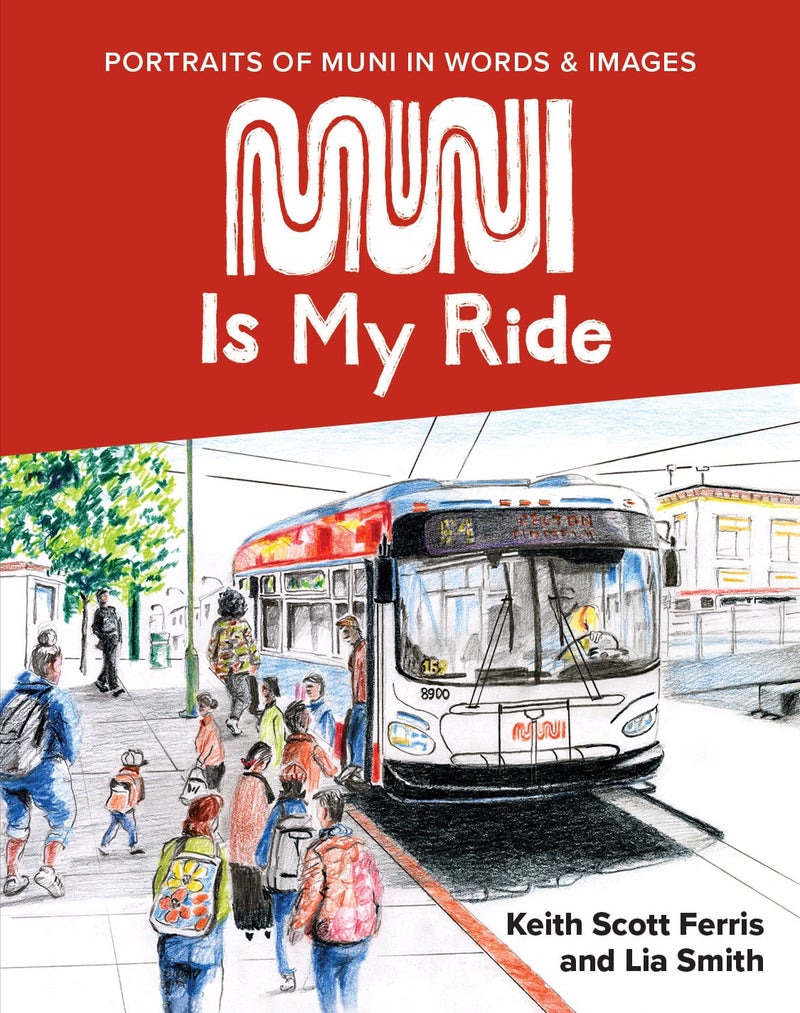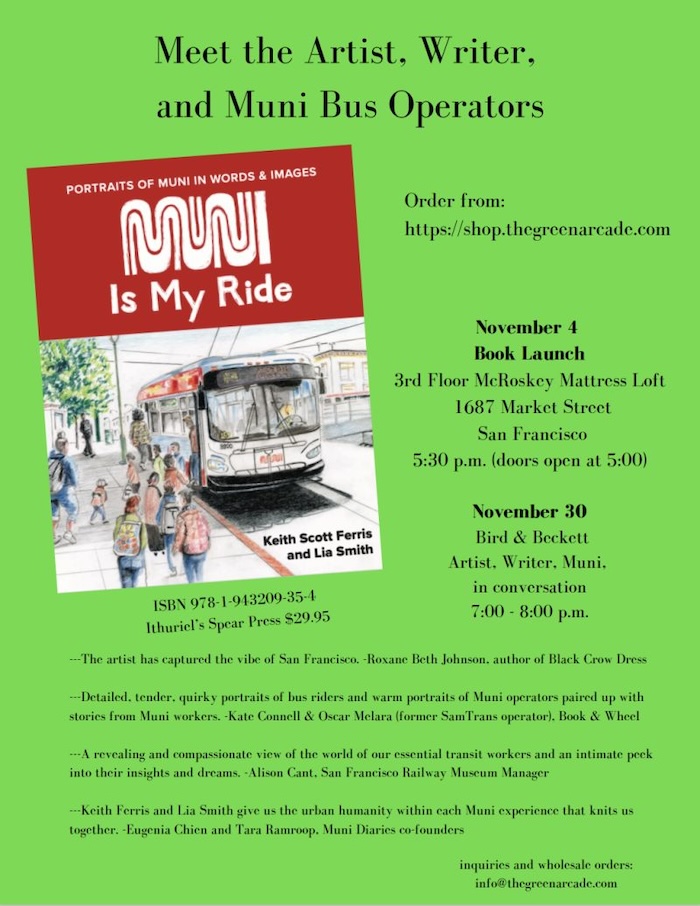Incredible progressive bookstore and activist oasis The Green Arcade on Market Street may be gone, but its spirit is living on via publishing and events. Owner Patrick Marks has moved his considerable attentions to putting out books that reflect the bookstore’s civic dedication and radical politics—and hey, they’re mighty nice-looking, too.
Case in point: Muni Is My Ride: Portraits Of Muni In Words And Images, a new book illustrated by Keith Scott Ferris and written by Lia Smith, put out by Green Arcade publishing partner Ithuriel’s Spear (best name ever). Muni Is My Ride consists of “colored pencil portraits of Muni operators, drawings of bus passengers, and B&W line drawings of bus stops by San Francisco artist Keith Ferris, accompanied by writer Lia Smith’s in-depth interviews of Muni operators, who detail their day-to-day realities transporting passengers throughout the City and explain what drew them to the profession.”
In fact, why not take Muni to the Sat/4 book launch event, 5:30pm-7:30pm at McRoskey Mattress Factory, across the street from the former bookstore, and party with the authors, operators, and other Muni aficionados. (There will be another event November 30 at Bird & Beckett Books.) While we’re approaching that destination, I spoke with the Muni Is My Ride crew about how the book came to be, what it takes to capture a driver’s hands, and how our Muni drivers are doing right now.
48 Hills Patrick, tell me how Green Arcade is continuing on as a publisher, and what plans you have in store besides this book.
PATRICK MARKS, PUBLISHER After the writer and activist Francesca Rosa (aka F. S. Rosa) died in 2016, I have been working with the founder and publisher of Ithuriel’s Spear, James Mitchell, and took on the role of publisher a couple years ago. It is now under the aegis of The Green Arcade. I have just finished copyediting Francesca’s last writing, a novel that was completed after her death by Sin Soracco, author of Low Bite. It is a noirish tale about some 1970s Viet Nam veterans and their drag queen circle. I also have some “secret” projects, one involving the unpublished writings of former Cockette director Michael Kalman. Oops, the secret is out. Another manuscript is under wraps!

48 HILLS What do you see as the importance of putting out a book like Muni Is My Ride (and how did the book come about)?
PATRICK MARKS Lia and Keith approached me after they read an article by Jim Mitchell in The San Franciscan Magazine—that about fog signals in San Francisco Bay! I was still running The Green Arcade on Market Street, and my focus on Bay Area history attracted them. I was so impressed by the project, I took it on. Muni Is My Ride is an art book, but also strong labor history and San Francisco urbanism, and it comes at a crucial time when public transportation is taking a hit from so many forces.
48 HILLS Keith, How did you approach creating the drivers’ portraits? Were there any particular challenges or techniques in capturing their personalities?
KEITH SCOTT FERRIS ILLUSTRATOR At first, I listened to what the operator had to say, when we first introduced ourselves. And then I sat down with a sketchbook and did a few quick sketches while Lia interviewed them. At a certain point, usually at a pause in the interview, I asked the operator if I could take a photograph, which I would use as a reference for their portrait. Later, in the studio, I would work off the sketches, the photograph, and what I had learned from what the operator said.
A couple of technical challenges were that one of the photographs of an operator was backlit from the light coming from the window behind him so I couldn’t make out his face very well. In that case, I had to really rely on my memory about his features. A driver was preparing his breakfast while Lia conducted the interview.
To capture their personalities, I would notice if an operator had any particular movements they made with their faces, or their hands. For example, I was really happy with how Dustin Well’s hands came out. Technically, his hands were a challenge, his left-hand fingers threaded through the right-hand fingers in sort of a fist, but I like how they turned out because I feel they say something about his personality.

48 HILLS Lia, what were some of the surprises or particularly interesting moments that came out during the interviews? How does it seem our Muni drivers are doing right now in general?
LIA SMITH, WRITER I was happy to learn that people of all ages and walks of life can and do apply to become Muni operators and to learn how supportive Muni is when operators are in training. Several of the operators related how they’d failed the driving tests but were encouraged to reapply.
Across the interviews, I learned a lot about how the training and selection process works. From working as a writing instructor for San Francisco’s Department of Human Resources, I already knew a lot about the enormous obstacles prospective city employees must overcome to get through the application process, and Harley de Vera’s experience, included in the book, was a case in point. I think Cynthia Bailey’s statement, which many other operators echo, is what everyone needs to hear: Driving a bus is not a hard labor job. It’s a mental job.
What is most gratifying is being able to bear witness to how much and how deeply operators think about their job, care about what they’re doing, and are committed to public transportation and serving the public. The surprises mostly came when I was gently disabused of any stereotypes I held in my glamorizing of operators. When Mark Spencer rattled off the hazardous conditions of being a cable car grip, I was taken aback at how little I had considered the working conditions of cable car operators.
I don’t know enough to make a blanket statement about how Muni operators are doing right now. However, I do know that if there are service cuts, which are looming because we’re coming to the end of the COVID emergency federal funding, the operators are going to bear the brunt of the fallout from frustrated, disgruntled, and despairing passengers—and I’m very concerned about that. As Charles Haletky points out, “The business of transit is fundamentally human. Whether you’re running it as management, working in it, or a passenger, you can’t forget that it’s a human institution with all the frailties and all that being human beings bring to the enterprise.”
‘MUNI IS MY RIDE’ BOOK LAUNCH PARTY Sat/4, 5:30pm-7:30pm, McRoskey Mattress Factory (third floor), SF. More info here.




